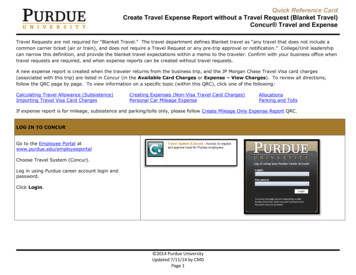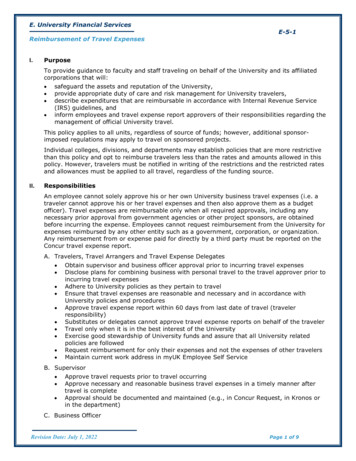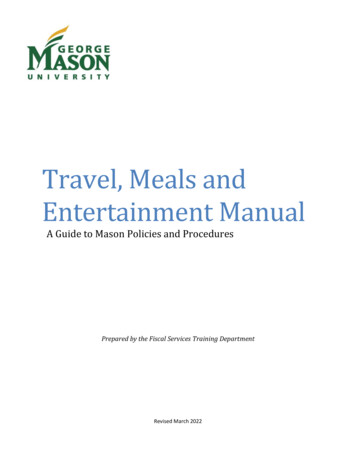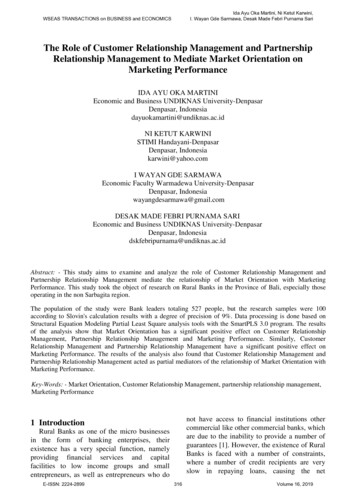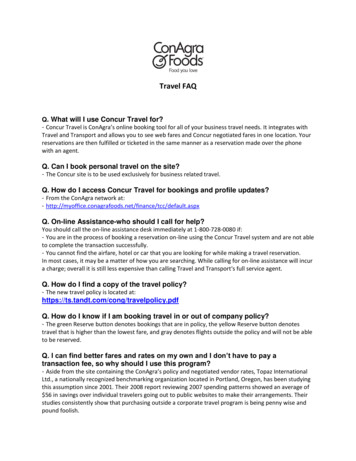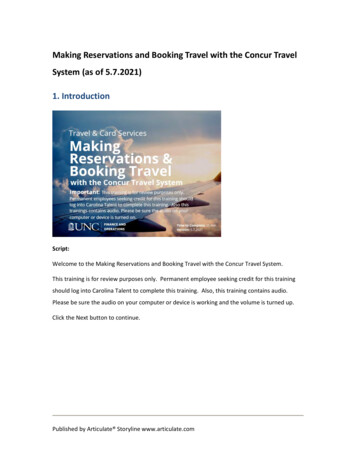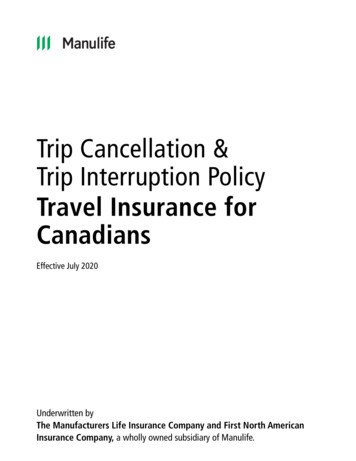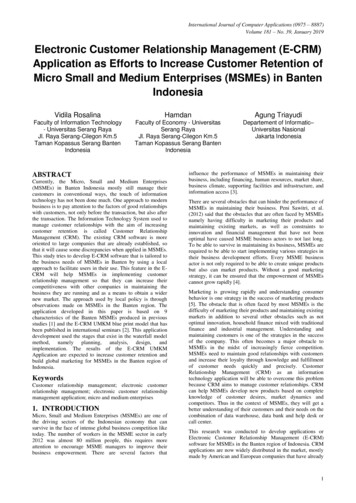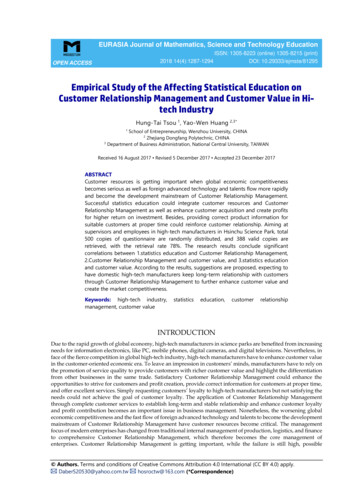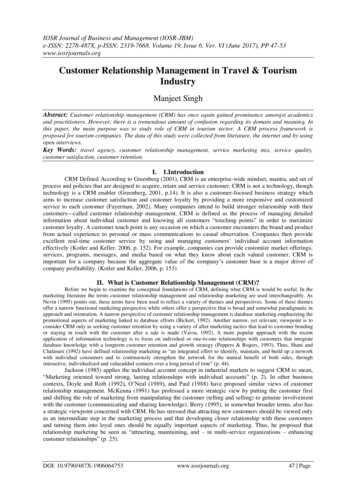
Transcription
IOSR Journal of Business and Management (IOSR-JBM)e-ISSN: 2278-487X, p-ISSN: 2319-7668. Volume 19, Issue 6. Ver. VI (June 2017), PP 47-53www.iosrjournals.orgCustomer Relationship Management in Travel & TourismIndustryManjeet SinghAbstract: Customer relationship management (CRM) has once again gained prominence amongst academicsand practitioners. However, there is a tremendous amount of confusion regarding its domain and meaning. Inthis paper, the main purpose was to study role of CRM in tourism sector. A CRM process framework isproposed for tourism companies. The data of this study were collected from literature, the internet and by usingopen interviews.Key Words: travel agency, customer relationship management, service marketing mix, service quality,customer satisfaction, customer retention.I. 1.IntroductionCRM Defined According to Greenberg (2001), CRM is an enterprise-wide mindset, mantra, and set ofprocess and policies that are designed to acquire, retain and service customer. CRM is not a technology, thoughtechnology is a CRM enabler (Greenberg, 2001, p.14). It is also a customer-focused business strategy whichaims to increase customer satisfaction and customer loyalty by providing a more responsive and customizedservice to each customer (Fayerman, 2002). Many companies intend to build stronger relationship with theircustomers---called customer relationship management. CRM is defined as the process of managing detailedinformation about individual customer and knowing all customers “touching points” in order to maximizecustomer loyalty. A customer touch point is any occasion on which a customer encounters the brand and productfrom actual experience to personal or mass communications to casual observation. Companies then provideexcellent real-time customer service by using and managing customers’ individual account informationeffectively (Kotler and Keller, 2006, p. 152). For example, companies can provide customize market offerings,services, programs, messages, and media based on what they know about each valued customer. CRM isimportant for a company because the aggregate value of the company’s customer base is a major driver ofcompany profitability. (Kotler and Keller, 2006, p. 153)II. What is Customer Relationship Management (CRM)?Before we begin to examine the conceptual foundations of CRM, defining what CRM is would be useful. In themarketing literature the terms customer relationship management and relationship marketing are used interchangeably. AsNevin (1995) points out, these terms have been used to reflect a variety of themes and perspectives. Some of these themesoffer a narrow functional marketing perspective while others offer a perspective that is broad and somewhat paradigmatic inapproach and orientation. A narrow perspective of customer relationship management is database marketing emphasizing thepromotional aspects of marketing linked to database efforts (Bickert, 1992). Another narrow, yet relevant, viewpoint is toconsider CRM only as seeking customer retention by using a variety of after marketing tactics that lead to customer bondingor staying in touch with the customer after a sale is made (Vavra, 1992). A more popular approach with the recentapplication of information technology is to focus on individual or one-to-one relationships with customers that integratedatabase knowledge with a longterm customer retention and growth strategy (Peppers & Rogers, 1993). Thus, Shani andChalasani (1992) have defined relationship marketing as “an integrated effort to identify, maintain, and build up a networkwith individual consumers and to continuously strengthen the network for the mutual benefit of both sides, throughinteractive, individualized and valueadded contacts over a long period of time” (p. 44).Jackson (1985) applies the individual account concept in industrial markets to suggest CRM to mean,“Marketing oriented toward strong, lasting relationships with individual accounts” (p. 2). In other businesscontexts, Doyle and Roth (1992), O’Neal (1989), and Paul (1988) have proposed similar views of customerrelationship management. McKenna (1991) has professed a more strategic view by putting the customer firstand shifting the role of marketing from manipulating the customer (telling and selling) to genuine involvementwith the customer (communicating and sharing knowledge). Berry (1995), in somewhat broader terms, also hasa strategic viewpoint concerned with CRM. He has stressed that attracting new customers should be viewed onlyas an intermediate step in the marketing process and that developing closer relationship with these customersand turning them into loyal ones should be equally important aspects of marketing. Thus, he proposed thatrelationship marketing be seen as “attracting, maintaining, and – in multi-service organizations – enhancingcustomer relationships” (p. 25).DOI: 10.9790/487X-1906064753www.iosrjournals.org47 Page
Customer Relationship Management in Travel & Tourism IndustryBerry’s notion of customer relationship management resembles that of other scholars studying servicesmarketing, such as Gronroos (1990), Gummesson (1987), and Levitt (1983). Although each one of them hasespoused the value of interactions in marketing and its consequent impact on customer relationships, Gronroosand Gummesson take a broader perspective and advocate that relationships with customers be the focus anddominant paradigm of marketing. For example, Gronroos (1990) states: “Marketing is to establish, maintain,and enhance relationships with customers and other partners, at a profit, so that the objectives of the partiesinvolved are met. This is achieved by a mutual exchange and fulfillment of promises” (p. 138). The implicationof Gronroos’ definition is that forming relationships with customers is the "raison de etre" of the firm andmarketing should be devoted to building and enhancing such relationships. Similarly, Morgan and Hunt (1994)draw upon the distinction made between transactional exchanges and relational exchanges by Dwyer, Schurr,and Oh (1987) to suggest that relationship marketing “refers to all marketing activities directed towardestablishing, developing, and maintaining successful relationships.” The core theme of all CRM and relationshipmarketing perspectives is its focus on a cooperative and collaborative relationship between the firm and itscustomers, and/or other marketing actors. Dwyer, Schurr, and Oh (1987) have characterized such cooperativerelationships as being interdependent and long-term orientated rather than being concerned with short-termdiscrete transactions. The long-term orientation is often emphasized because it is believed that marketing actorswill not engage in opportunistic behavior if they have a long-term orientation and that such relationships will beanchored in mutual gains and cooperation (Ganesan, 1994).Another important facet of CRM is “customer selectivity.” As several research studies have shown, notall customers are equally profitable for an individual company (Storbacka, 2000). The company therefore mustbe selective in tailoring its program and marketing efforts by segmenting and selecting appropriate customersfor individual marketing programs. In some cases, the “outsourcing of some customers” could be called for sothat a company allocates its resources to those customers it can serve the best in order to create mutual value.However, the objective of a company is not really to prune its customer base but to identify the programs andmethods that would be the most profitable as it creates value for the firm and the customer. Hence, ourdefinition of CRM is thatCustomer Relationship Management is a comprehensive strategy and process of acquiring, retaining,and partnering with selective customers to create superior value for the company and the customer. It involvesthe integration of marketing, sales, customer service, and the supply-chain functions of the organization toachieve greater efficiencies and effectiveness in delivering customer value.As is implicit in the above definition, the purpose of CRM is to improve marketing productivity.Marketing productivity is achieved by increasing marketing efficiency and by enhancing marketingeffectiveness (Sheth & Sisodia, 1995). In CRM, marketing efficiency is achieved because cooperative andcollaborative processes help in reducing transaction costs and overall development costs for the company. Twoimportant processes of CRM include proactive customer business development and building partneringrelationships with the most important customers. These lead to superior mutual value creation.III. CRM ObjectivesWhen an organization implementing CRM, there are various descriptions on the objectives for them,but the ultimate goal is to gain benefits. In this research, the authors will only discuss some selected ones whichare important and relevant. According to Greenberg (2001), there are several objectives when organizationimplementing CRM:1) Increase Revenue2) Improve global forecast and pipeline management3) Improve win probability4) Reduce cost of sales5) Increase sales representative productivity6) Promote sales representative retentionAccording to Kim et al. (2003), it is more focusing on customer-oriented objectives. There are four categories:1) Customer Knowledge, meaning that firms focus on gathering appropriate customer information, analyzingcustomer data, training employees, etc. in order to improve the quality of services they provide.2) Customer Interaction, meaning that firms focus on the interactions with customers. For example, theyprovide quick and appropriate response to customer request, customizing products and services, etc.3) Customer Value, for example, customer retention improvement, increase of customer profitability.4) Customer Satisfaction, firms want to build long-term relationships with customers by improving the servicequality.DOI: 10.9790/487X-1906064753www.iosrjournals.org48 Page
Customer Relationship Management in Travel & Tourism IndustryIV. Indentify customersCustomers could be interested in either a relational or transactional contact with a firm. It may notalways be a profitable for a firm to be relationship-oriented, because not all customers will be interested informing relationship with service providers (Grönroos, 2007, p.37). So it is good for firms to identify theircustomers before forming relationships. On the other hand, it is difficult for a firm to satisfy everyone in amarket because different customers have different preferences. Therefore, firms should identify and profiledistinct groups of buyers who might require varying product and services. The marketers then decide their targetmarket and target customers by evaluating which segments present the biggest opportunity (Kotler and Keller,2006, p.24). 3.2.4 Customer database and database Marketing Marketers must know their customers. Companiesmust collect information of individual customers and store in a database and do database marketing in order toknow the customers. A customer database is an organized collection of detail information about individualcustomers which is current, accessible, and actionable for marketing purposes such as providing good service, ormaintaining long-term customer relationships. Database marketing is the process of building, maintaining, andusing customer databases and other databases (products, suppliers, resellers) to contact, transact, and buildcustomer relationships (Kotler and Keller, 2006, p.162)V. Customer satisfaction measurementMeasuring customer satisfaction is a good way to know if customers received the same service withtheir expectations and it is an important factor in building customer relationship. Customer satisfaction is oftenmeasured by finding out the difference between service quality and customer satisfaction and a comparison ofexperiences with prior expectations (Grönroos, 2007, p.89). A number of methods exist to measure customersatisfaction. For example:1) Periodic surveys. It is an easy way to track customer satisfaction directly. For customer satisfaction surveys,it is important that companies ask the right questions.2) Customer loss rate can be monitored by companies. Companies contact customers who have stopped buyingor who have switched to another supplier to learn why this happened.3) In addition to tracking customer value expectations and satisfaction, companies need to monitor theircompetitors’ performance in these areas (Kotler and Keller, 2006, p.146).For customer-centered companies, customer satisfaction is both a goal and a marketing tool (Kotler and Keller,2006), even though it may end up spending a lot of money for its implementation (Chi & Gursoy, 2009).VI. Customer RetentionAccording to Gilbert (1996), he mentioned that nowadays companies should focus on the relationshipmarketing perspective rather than focusing on the traditional marketing which is defined as “the managementprocess of identifying, anticipating and satisfying customer requirements profitably” (Gilbert, 1996, p.576).Grönroos (1991) assumes that marketing strategies have different characteristic which vary from transactional torelational marketing, and a relationship is usually long-term oriented.VII.CRM and Travel & Tourism SectorGlobalization, increasing competition and advances in information and communication technology hasforced companies to focus on managing customer relationships in order to efficiently maximize revenues(Ozgener, & Iraz, 2006). In today’s environment, firms are increasingly dependent on the relationship they havewith their customers. With the implementation of customer relationships, firms often achieve greater payoff,such as positive word of mouth, referrals and loyalty (Kim & Cha, 2002). In particular for service business,managing customer relationship is important because of the inherent intangibility and heterogeneouscharacteristics associated with service delivery (Cheng, Chen, and Chang, 2008). Customer RelationshipManagement (known as CRM) is defined as the process of managing detailed information about individualcustomers and developing stronger relationship with customers to maximize customer loyalty (Kotler andKeller, 2006, p.152).Furthermore, CRM is considered as a key competitive strategy which companies need to focus on theneeds of the customers and to integrate a customer-facing approach throughout the organization. (Ozgener, &Iraz, 2006). Khalifa and Liu (2001) stated that, a survey of more than 1600 businesses and IT professionalswhich is conducted by Data Warehouse Institute, found that, some of the respondents have CRM projectbudgets of over 10 million. By using information and communication technology, businesses are trying to getcloser to customers so that they can create a long-term customer relationship. Thus, deploying CRM initiativeshas become very common (Ozgener, & Iraz, 2006). On the other hand, in the present age of economicglobalization, tourism supplies and demands become one of the most exciting, progressive and one of the largestindustries in the world (Jiang & Cui, 2009). The World Tourism Organization (UNWTO) forecasts thatinternational tourism will continue growing at the average annual rate of 4 %, expected to reach over 1.56DOI: 10.9790/487X-1906064753www.iosrjournals.org49 Page
Customer Relationship Management in Travel & Tourism Industrybillion by the year 2020. Of these worldwide arrivals in 2020, 1.2 billion will be intraregional and 377 millionwill be long-haul travelers. Long-haul travels will grow slightly faster than intraregional travels and by 2020 itsshare will increase from 18 % in 1995 to 24 %. By 2020, Europe will still be considered as the most populardestination, but its share will drop from 60 % in 1995 to 46 % (Long-term Prospects: Tourism 2020 Vision,World Tourism, 2004).In its broadest sense, the tourism industry is the total of all businesses which directly provides goods orservices to facilitate business, pleasure and leisure activities away from the home environment. Thus, tourism isa big business which has effects on almost every industry. It is said that nowadays tourism becomes everyone’sbusiness because everyone gains if travels are planned and managed in a proper way. Tourism brings significantbenefits for regional areas by diversifying the area’s economic base and expanding the employment market(Tourism, 2010).VIII.Theoritical Framework8.1.Problem DiscussionReferring to tourism, the role of travel agencies as intermediaries for distribution of airline reservations,ticketing, transactions (Vasudavan & Standing, 1999) has changed. Since customers prefer travel agencies thatcan provide customized service, give expert advice on destinations, and assist in planning complex trips (Bureauof Labor Statistics, U.S. Department of Labor, 2007). A focus on customer relationships like providingcustomers value-added services, expert advice, and recommendations is becoming essential. Travel agenciesprovide invisible services to customers directly, and so customers are the most important and valuable intangibleassets for them. Customers' satisfactions are much more important than the earnings of travel agencies.Therefore, compared with other organizations, travel agencies need to establish their own business idea whichregards customers as centre, and improve their competitiveness by building and developing customerrelationship (Jiang & Cui, 2009). This is the reason why it is of interest to explore travel agencies and their useof CRM.8.2.QuestionsThe research questions are formulated as follows:How does Travel agency use Customer Relationship Management in their business?What are the most important objectives for agency when they conduct customer relationshipmanagement?8.3.PurposeThe purpose of this is to describe how agency uses customer relationship management.8.4.Target GroupThis is beneficial for travel agent, as well as tour operators, to evaluate their service and to find out thecustomer’s expectation. It will also be of interest for other service companies who want to know how to keepcustomers’ loyalty and satisfaction. Furthermore, it may be useful for students who want to conduct researchwhich is associated to the customer relationship management.8.5.The Nature of ServiceAny performance or action that one party can offer to another that is essentially intangible is defined asa service (Kotler & keller, 2006, p.402). Services are deeds, processes, and performances which include “alleconomic activities whose output is not a physical product or construction, is generally consumed at the time itis produced, and provides added value in forms (such as convenience, amusement, timeliness, comfort or health)that are essentially intangible concern of its first purchaser” (Grönroos, 2006, p.4).8.6.The Service Marketing Mix (The 7 P’s)Marketing mix is one of the basic concepts in marketing which is defined as the elements anorganization need to have in order to satisfy or communicate with customers. The four Ps (product, price, placeand promotion) is used in the traditional marketing mix. These four elements are considered as main variables inany marketing plans. All of those variables, to some extent, are interrelated and depend on each other (Zeithamlet al., 2006, p.25).According to Zeithaml (2006), service is usually produced and consumed simultaneously, so customerssometimes have to interact with the service firms directly which is considered as a process of the serviceproduction. Besides, in order to understand the nature of the service experience, customers always have to lookfor physical cues. The awareness of the importance of these additional variables has led service marketers toadopt the concept of an expanded marketing mix for services, including people, physical evidence and process(Zeithaml et al., 2006, pp.25, 26).DOI: 10.9790/487X-1906064753www.iosrjournals.org50 Page
Customer Relationship Management in Travel & Tourism IndustryAll of the marketing mix elements may affect the consumer’s initial purchase decision, the customer’ssatisfaction level and repurchase decisions (Zeithaml et al., 2006, p.27). On the other hand, devising marketingactivities and programs to create, communicate, and deliver value for consumers are the main tasks for almostall the marketers (Kolter & Keller, 2006, p.19).Figure : Expanded Marketing Mix for Services8.6.1.Product: It could be a physical product or an intangible service. Referring to tangible products, somecharacteristics are mentioned as shown in the figure, namely, the product variety, quality, design, features,branding, packaging, warranties etc.8.6.2.Place: It is the place where products can be sold, and associated with channels of distribution in order tooffer products to target customers. There are a lot of different channels, for example, retail, wholesale, mailorder, internet etc.8.6.3.Price: Price is the amount of money which customers pay for the product. There are different strategies tomake pricing decisions, like cost-plus, penetration, so pricing includes not only list price, but also discounts,allowance, and so on.8.6.4.Promotion: In order to sell products and to draw attention from customers, marketers use any differentkinds of communication tools to do promotion, like advertising, public relations, special offers, free gifts etc(Inspired by Figure2).8.6.5.People: All human actors who involve in the process of service delivery and their actions could influencebuyer’s perceptions. For example, the firm’s personnel, the consumers are people in the process of service.(Zeithaml et al., 2006, p.26)8.6.6.Physical evidence: The environment where the service is delivered, where the firm and customer interactand contact with each other. Tangible components that facilitate performance or communication of the servicecould be considered as physical evidence as well (Zeithaml et al., 2006, p.26-27).DOI: 10.9790/487X-1906064753www.iosrjournals.org51 Page
Customer Relationship Management in Travel & Tourism Industry8.6.7.Process: It is the actual procedures and flows of activities by which the service is delivered, namely, theservice delivery and operating systems. (Zeithaml et al., 2006, p.26-27).9.Service QualityIn regard to Zeithaml (2006), research suggests that customers’ percepetion of quality is based on multiplefactors relevant to the context. The dimensions of service quality have been identified through the researches.(Zeithaml et al., 2006, p.116). These five determinants (shown in Figure ) characterize customers’ perception ofthe service. (Grönroos, 2007, p.84)Figure 4: The five dimensions of service quality (Inspired by Grönroos)These dimensions, as drivers of service quality, explain how consumers organize information delivered to themin their minds.9.1.Reliability: Delivering on promisesReliability has been considered to be the most important to the perceptions of service quality of the fivedimensions. It is defined as the ability to perform the promised service dependably and accurately. Customersalways would like to do business with companies that keep their promises and core service attributes. (Zeithamlet al., 2006, p.116)9.2.Responsiveness: Being willing to helpResponsiveness is the willingness to help customers and to provide good service. This demension means thatfirms should be attentiveness and promptness in dealing with customer questions, complaints, and problems.Customers may evaluate responsiveness of a firm by the length of time they have to wait for assistance, answerquestions, or attention to their problems. Responsiveness captures the notion of flexibility and ability of a firmto customize the service according to customer needs. (Zeithaml et al., 2006, p.117)9.3.Assurance: Inspiring trust and confidenceAssurance is the ability of the firm and its employees’ knowledge and courtesy to inspire trust and confidence.This dimension plays a particularly important role in the services that customers perceive as high risk or forservices which they feel uncertain about firms’ ability to evaluate outcomes. (Zeithaml et al., 2006, p.118)9.4.Empathy: Treating customers as individualsEmpathy is the caring, individualized attention and customized service that the firm provides to its customers.The essence of empathy is providing personalized or customized service to make customers feel that they areunique, special and that their needs are understood. (Zeithaml et al., 2006, p.119)9.5.Tangibles: Representing the service physicallyTangibles are the appearance of physical facilities, equipments, personnel, and communication materials.Tangibles provide physical images of the service that customers, particularly new customers, will use toevaluate quality (Zeithaml et al., 2006, p.117).DOI: 10.9790/487X-1906064753www.iosrjournals.org52 Page
Customer Relationship Management in Travel & Tourism IndustryIX. ConclusionStudy supports the original thought that CRM is diversely needed and maintained in tourism sector. Italso shows that it has been possible to stabilize CRM both in operating area among competitors as well asamong consciousness of customers.Major importance of CRM is an explicit division of its areas that are applied to reach the most profitthrough the most suitable method. These various methods can be used for improving the operations to managethe challenges that tourism and travel sector eau of Labor Statistics, U.S. Department of Labor. (2007). Occupational Outlook Handbook, 2008-2009 Edition. Travel Agents.Retrieved November 4, 2009 from ad-dress: http://www.bls.gov/oco/ocos124.htm.Chi, C. G., & Gursoy, D. (2009), “Employee satisfaction, customer satisfaction, and financial performance: An empiricalexamination”, International Journal of Hospitality Management, Volume 28, pp. 245-253Christian Grönroos, Service Management and Marketing: Customer Management in Service Competition , 3rd Edition, JohnWiley & Sons Ltd., 2007.Claycomb, C., & Martin, C. L. (2002), “Building Customer Relationship: An Inventory of Service Providers’ Objectives andPractices”, Journal of Service Marketing, 16(7), Pages 615-635.Cui Zhenxing and Jiang Hua, Study on Tourism CRM Based on Fuzzy Evaluation/ Journal of 2009 Sixth International Conferenceon Fuzzy Systems and Knowledge Discovery, Volume 6, 2009, page 428-431Clarke, A.Tourism Management: Analysis, Behaviour and Strategy, Tourism Management, Volume 31, Issue 1, Year 2010 Pages148--149David Gilbert and Robin K. C. Wong/Tourism Management, Volume 24, Issue 5, October 2003, Pages 519-532E. Arnould, L. Price and G. Zinkhan, Consumers , 2nd Edition, McGrw-Hill, New York.Eric Laws, Tourism Marketing: Quality and Service Management Perspectives , Continum, 2002.Fayerman, M., (2002), Customer Relationship Management. New Directions for Institutional Research, Vol.1, No.112, pp. 57-67.Driggs Woody, Your customers want you to know them/ Journal of customer relationship management, Volume: 13, issue4, 2009,page 14.Eric Pels, Research in Transportation Economics/ The Economics of Low Cost Airlines, Volume 24, Issue 1, 2008, Pages 68-74Fisher, C. (2007). Researching and writing a dissertation, a guidebook for business students. EssexEngland: Prentice Hall, p. 5,pp.31-33.Goldenberg Barton, Assessing your CRM situation/Journal of customer relationship management, Volume14, Issue1, 2010, page10Gefen, D. & Ridings, C. M., (2002), Implementation team responsiveness and user evaluation of customer relationshipmanagement: A quasi-experimental design study of social exchange theory. Journal of Management Information system, Vol.19,No.1, pp.47-69.Ghauri, P., Gronhaug, K., (2005), Research Methods in Business Studies: A Practical Guide , 3rd. Edition, Prentice-Hall,Financial Time, London, England.Greenberg, P. (2001), CRM at the Speed of Light: Capturing and Keeping Customers in Internet Real Time. Berkeley:Osborne/McGraw-Hill.Gummesson, E., Internal Marketing in the light of relationship marketing and virtual organizations. In Lewis, B. & Varey, R. (eds),Internal Marketing. London: Routledge, 2000.Gursoy, D., Swanger, N., (2007), “Performance-enhancing internal strategic factors: impacts on financial success”. InternationalJournal of Hospitality Management, Vol. 26, No.1, Pages 213-227Heskett, J. L., Jones, T. O., Loveman, G. W., Sasser, W. E., Schlesinger, L. A., (1994), ”Putting the service-profit chain to work”,Harvard Business Review, Vol.72, No.2, pp.164-175.Jao-Hong Cheng, Fang-Yuan Chen, and Yu-Hern Chang, Tourism Management, Volume 29, Issue 3, June 2008, pp. 487-499.Kim, J., Suh, E. & Hwang, H. (2003), A Model of Evaluating the Effectiveness of CRM using the Balanced Scorecard. Journal ofInteractive Marketing. Vol.17, No.2, p. 5-19.Kim, W., G., & Cha, Y., “Antecedents and consequences of relationship quality in hotel industry”, International Journal ofHospitality Management, Volume 21, 2002, Pages 321-338Lundahl, U., & Skärvad, P-H. (1999). Utredningsmetodik för samhällsvetare ochekonomer. Lund: Studentlitteratur.Musico Christopher, Hold onto your customers! / Journal of customer relationship management, Volume:13, Issue:2, 2009, Pages30-35Ozgener, S.; Iraz, R.,”Customer relationship management in small-medium enterprises: The case of Turkish tourismindustry”,Tourism Management, Volume 27, Issue 6,Year 2006, Pages 1356-1363Philp Kotler, Kevin Lane Keller, Marketing Management , 12th.edition, Pearson Prentice Hall, cop. 2006Powney, J., Watts, M. (1987), Interviewing in Educational Research. London: Taylor & Francis.Saunders, M., Lewis, P., Thornhill, A. (2007), Research Methods for Business Students , 4th. Edition, Prentice Hall, Harlow.Richard L. Oliver, Satisfaction: A behavioral Perspecti
customers---called customer relationship management. CRM is defined as the process of managing detailed information about individual customer and knowing all customers "touching points" in order to maximize customer loyalty. A customer touch point is any occasion on which a customer encounters the brand and product
